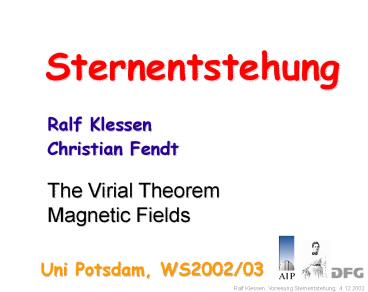Sternentstehung PowerPoint PPT Presentation
1 / 14
Title: Sternentstehung
1
Sternentstehung
Ralf Klessen
Christian Fendt
The Virial Theorem Magnetic Fields
Uni Potsdam, WS2002/03
2
Virial Theorem Application to MCs
see separate handout
3
Virial Theorem Application to MCs 1
4
Virial Theorem Application to MCs 2
5
Virial Theorem Application to MCs 3
6
Virial Theorem Application to MCs 4
7
Magnetic Fields 1 -- Overview
- How does interstellar gas couple to magnetic
field lines? - What is the typical strength of magnetic fields?
- How do we measure fields (direction as well as
strength)? - How does the B-field influence star formation?
gyration, collisions between neutrals and ions
B??1/2 with B? 1100 ?G standard value in ISM
3?G
synchrotron emission, dispersion and rotation
measure, Zeeman effect
standard theory of SF vs SF controlled by
supersonic turbulence
8
Magnetic Fields 2 -- Strength
B versus N(H2 ) from Zeeman measurements. (from
Bourke et al. 2001) ?? cloud cores are
magnetically supercritical!!!
observed B-field
B??1/2 - with B? 1100 ?G - standard value in
dilute ISM 3?G
(?/M)n gt 1 no collapse (?/M)n lt 1 collapse
column density
9
Magnetic Fields 3 -- Synchrotron
- Non-thermal synchrotron emission
- Source Relativistic electrons in magnetic field
- Energy distribution of e- follows a power law
(not Maxwell, and therefore non-thermal
emission) N(E) dE µ E-p dE - The energy emitted in the frequency interval ?
, ? d? equals the energy lost by the
e- in a certain energy interval E, E dE - I(?) d?
(dE/dt) N(E) dE - with E g me c2
- and
- where ?T is the Thomson scattering cross
section and ?0 is the permeability. - It follows that I(?) ? B(p1)/2 ? - (p - 1)/2
(see plot at the right side) - The exponent of the energy distribtution of
electrons is p 1,8 ... 2,8.
10
Magnetic Fields 4 -- Rotation
- Faraday rotation and dispersion
- A plane-polarised wave can be thought of as two
circularly-polarised waves that rotate in
opposite directions - The gyration of the electrons causes the two
circular polarisations to propagate at
different speeds - where the gyration frequency is
- This causes the two modes to get out of phase as
they propagate, resulting in a net
rotation. - It is
angle turned through
propagation time
Hence
and thus
11
Magnetic Fields 5 -- Dispersion
- Faraday rotation and dispersion
The speed of propagation of light through a
plasma is not constant but depends on the
electron density
where
is the plasma frequency
The flight time of photons is
For observations of the ISM we know ? gtgt ?P
We cannot measure t as we dont know when the
photon was emitted. If, however, we observe a
pulse of radiation, then the relative
light-travel time at different (but neighbouring)
frequencies can be used to measure using the
formula
12
Magnetic Fields 6 Disp. Rot.
- Faraday rotation and dispersion
By taking the ratio of the rotation and
dispersion measures one can estimate the mean
magnetic field along the line of sight
This usually under-estimates the true field! It
is assumed that the field is static and has no
small scale structure. A tangled magnetic field
would lead to depolarisation
13
Magnetic Fields 7 -- Zeeman
- The Zeeman effect
Line splitting due to the Lorentz force acting on
the electrons in the atom. Normal Zeeman effect
three frequencies ? ?0 e B/(2 m c)
e electron charge, m electron mass ?0 ?- ?
0 e B/(2 m c) The three components are
polarized (n0 linear, n/- circular) If
we observe along the B-field, then the
unperturbed frequency ?0 is not observed
(longitudinal Zeeman effekt). Example 21 cm
line of neutral hydrogen ( HI ) - assume B
10-6 Gauß then ?? ? 2,8 Hz - detection
of Zeeman splitting is extremely difficult (shift
is 10-4 of linewidth) - values of B
lie between 1 to 150 µGauß (roughly 30 detections
in protostellar cores, compared to about
twice as many non-detections, typically in OH and
CN) In dense molecular cloud cores the Zeeman
effect is best detected in OH or CN (Crutcher
1999, Bourke et al. 2001)
Term scheme of normal Zeeman effect
From Bourke et al. (2001) Zeeman detection in
two OH absorption lines top line profile
(averaged over the right and left handed circular
polarized components Ir, IL) in the direction of
Orion B bottom Stokes V vector (Ir IL) with
model fit (black line).
Adopted from B. Stecklum Physik der
Sternentstehung
14
Magnetic Fields 8 -- Dust
- The polarization by dust (see also last lecture)
Unlikely alignment
Unpolarized star light
Most likely alignment of dust grains in magnetic
field
Observed partial polarisation
Circular symmetric polarisation patter around an
O star that creates the ultra-compact HII region
G5.89-0.39. The cross in the center marks the
position of the light source which is invisible
at 2.2µm.
Vector of polarisation (E component) is parallel
to the projected field lines
Polarisation in the Taurus molecular cloud
Dust grains are elongated and are alignted
perpendicular to magnetic field vectors.
Adopted from B. Stecklum Physik der
Sternentstehung

